
Deposition Date
2020-08-20
Release Date
2020-09-30
Last Version Date
2023-10-18
Entry Detail
PDB ID:
7JUT
Keywords:
Title:
Crystal Structure of KSR2:MEK1 in complex with ANP-PNP, and allosteric MEK inhibitor Selumetinib
Biological Source:
Source Organism:
Homo sapiens (Taxon ID: 9606)
Oryctolagus cuniculus (Taxon ID: 9986)
Oryctolagus cuniculus (Taxon ID: 9986)
Host Organism:
Method Details:
Experimental Method:
Resolution:
3.09 Å
R-Value Free:
0.30
R-Value Work:
0.25
R-Value Observed:
0.25
Space Group:
P 61 2 2


